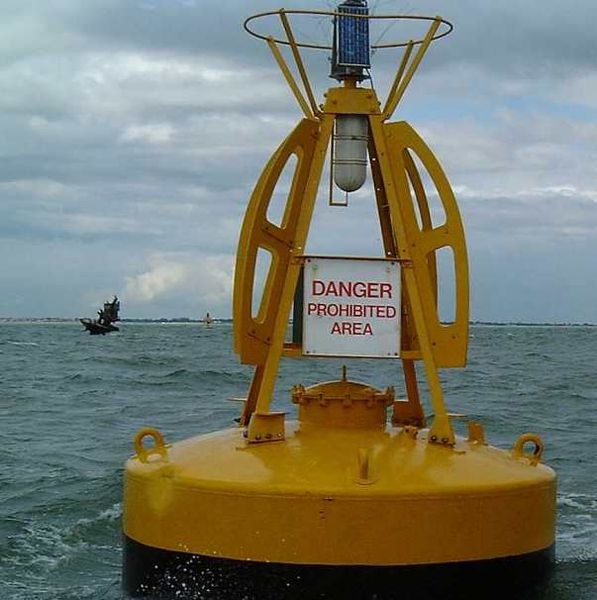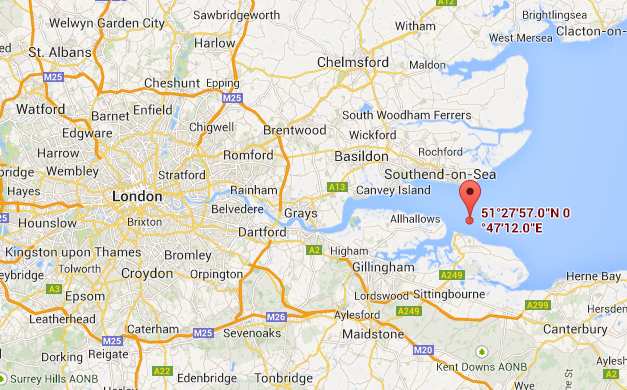The Wreck of the Richard Montgomery
The U-boat was a German submarine from World War II, one which at the time went unrivaled by the rest of the world. The German U-boat strategy, especially at the beginning of the war, involved targeting British cargo ships. These cargo ships, designed more for transport than for battle, were ill-prepared to defend themselves against the sub and similarly ill-suited to strike back, making them relatively easy targets. Destroying supply lines while taking little risk to one’s own fleet seemed to be a winning strategy for the German navy. In response, the American navy invested in the creation of Liberty ships — enormous freighters able to repel U-boat attacks — which were built on behalf of the British to help their merchant corps survive. Upon their completion, many Liberty ships were sent into British waters.
And one s still there. And no, you can’t go visit it. If you try, you’ll see the below.

Look past the yellow warning buoy — to the left — and you’ll see the mast of the SS Richard Montgomery, the Liberty ship in question. Its wreck is in the Thames Estuary, the body of water where the River Thames meets the North Sea. Here’s a map below; the red flag shows the location of the SS Richard Montgomery’s remains:

The United States built the Montgomery in the summer of 1943 and, in August of the following year, sent it to Europe loaded with over 6,000 tons of munitions. The trip from Philadelphia across the Atlantic was a non-issue and the Montgomery was transferred to British control upon its arrival near the UK. The ship was to be part of a larger convoy to France, which had recently been re-taken by the Allies after the successful D-Day invasion and the Battle of Normandy.
Unfortunately, a lot of bad luck and carelessness conspired to prevent that from happening. While most Liberty ships had a draught (that’s “the depth of a vessel’s keel below the water line”) of about 28 feet, the Montgomery’s was 31 feet, and therefore required more clearance than typical. It ended up running aground on a sandbank, which it only crashed into because the captain was sleeping and the second-in-command, for reasons unexplained, failed to alert him to the warning sirens emitted by other ships. When the tide waters dropped, the ship’s underside fractured dooming it to the bottom of the estuary. A month later, after a costly and mostly unsuccessful recovery operation, the hull broke in two. The wreck of the Montgomery remains stranded at that location.
That wouldn’t be such a big deal — there are plenty of wrecks littered throughout our seas and oceans — but the Montgomery didn’t go down empty. Remember, it was carrying explosives — a lot of explosives. An estimated 1,400-1,500 tons of TNT is sitting somewhere in or around the wreck, making it a bad idea to go visit the area. (Hence the buoy.) Per one report (pdf), a collision with the remains of the payload could result in a massive explosion, and the area is understandably off-limits. The BBC, in 1970, concluded that if the wreck were to explode, it could generate a wave 16 feet high, throw debris 3,000 feet skyward, and the blast would likely destroy every window in the nearby town of Sheerness (home to about 20,000 people).
These findings may be overstated — we really don’t have a good grasp of what’s going on underwater there — but everyone agrees that it is not a great idea to try and reclaim the wreckage. It’d be too expensive even if it went well, and if it went poorly, the damage would many any reclamation costs look tiny. For the time being — and likely, for decades to come — the mast will remain peeking out of the water, with that buoy warning people to sail elsewhere.
Bonus Fact: The first Liberty ship took about eight months to build, but over time, U.S. shipbuilders cut the turnaround time diametrically, to about six weeks. But in one case, they worked even more quickly than that: the USS Robert E. Peavy. It took less than five days to build — as a publicity stunt for the wartime efforts.
From the Archives: Bombs Away: The lost nuke off the coast of Georgia.
Related: An e-book about the real Richard Montgomery, for whom the shipwrecked vessel was named.
